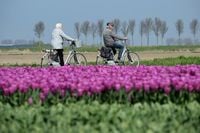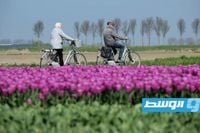In a stunning scene near Amsterdam, the vibrant blooms of the world’s largest flower market create a feast for the eyes and nose. However, this natural beauty is overshadowed by growing concerns over the Netherlands’ extensive use of pesticides in its flower fields, prompting increasing criticism from environmental and public health organizations.
Margriet Mantingh, head of the PAN-NL organization, recently highlighted this issue by publishing a study that reveals the alarming presence of pesticide residues in flowers purchased from shops or online. According to Agence France-Presse, some of these substances are banned in the European Union and may pose serious health risks, including cancer and fertility issues, while also threatening beneficial insects.
The debate intensified following the tragic death of a young girl in France, linked to blood poisoning from exposure to pesticides via her mother, a flower seller. This incident has sparked calls for increased safety measures, with the Dutch Flower Sellers Association (VBW) recommending that vendors wear gloves and wash their hands after handling flowers.
Royal FloraHolland, a major player in the global flower industry, is taking steps to address these concerns. The cooperative, which sells around 9 billion flowers annually and generates approximately 5.2 billion euros in revenue, announced that starting in 2026, it will require producers to obtain a sustainability certificate to measure chemical usage.
Despite these measures, activists argue that much more needs to be done to ensure the safety of flowers for consumers. Mantingh’s study found that out of 13 flower bouquets tested, 71 different pesticides were detected, with a third of them being substances prohibited in the EU.
“We found that many flowers contain pesticide residues that are extremely toxic to humans,” Mantingh stated, underscoring the urgency of the situation. The findings have raised alarms not just in the Netherlands but across Europe, as consumer associations like France’s UFC Que Choisir warn of the dangers posed by contaminated cut flowers.
In the bustling Aalsmeer flower market, dozens of employees navigate the vast hallways on electric carts, handling millions of blooms destined for export to countries like Germany, the UK, and France. However, the issue of pesticide use extends beyond the Netherlands, as many flowers imported from Africa, particularly Kenya and Ethiopia, are treated with substances that may not meet EU safety standards.
Bas Smit, a spokesperson for Royal FloraHolland, explained that the regulations governing pesticide use depend on the country of origin. “In Africa, there are different diseases than those in Europe, which requires different products to combat them,” he noted. This complicates the efforts to ensure that flowers imported into the EU are free from harmful residues.
Currently, the European Union has strict regulations regarding pesticide residues on fruits and vegetables but lacks similar measures for cut flowers. This regulatory gap has led to calls for more stringent oversight to protect consumers.
The tragic death of the young girl in France has catalyzed discussions about safety in the flower industry, with the VBW emphasizing the importance of safe handling practices. Marco Maasse, the director of VBW, stated, “This issue in France is alarming, and while we don’t know exactly what happened, we must ensure that everything is as safe as possible.”
However, Maasse also reassured consumers that no flowers sold in the Netherlands should pose a threat, saying, “If any bouquet was dangerous, it wouldn’t be allowed to be marketed.” Despite this, he acknowledged that with the Netherlands’ position as a leading flower exporter, there is a responsibility to set a positive example.
“We need to have a better understanding of the residues present on products when they enter the Netherlands,” Maasse added, calling for greater transparency across the supply chain. This sentiment is echoed by Mantingh, who argues that the flower industry must find a balance between aesthetic appeal and environmental responsibility.
As consumers continue to enjoy perfect blooms throughout the year, the question remains: can the global flower industry reconcile its beauty with the pressing need for environmental accountability? The answer may lie in stricter regulations, improved safety practices, and a commitment to sustainable flower production.
The rise of consumer awareness regarding the potential dangers of pesticide-laden flowers is a wake-up call for the industry. With organizations like PAN-NL and consumer advocacy groups pushing for change, the pressure is on for the Netherlands to lead the way in ensuring that the flowers adorning homes and events are not just beautiful but also safe for all.
As the debate continues, the flower market stands at a crossroads. Will it prioritize the health of consumers and the environment, or will it continue to prioritize beauty at the expense of safety? The coming years will be pivotal in determining the future of the flower industry, as both consumers and producers navigate the delicate balance between beauty and responsibility.






